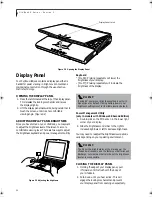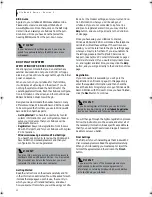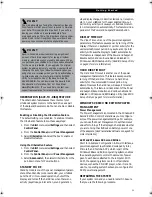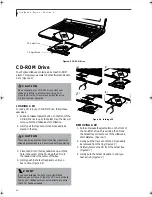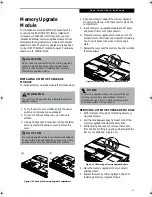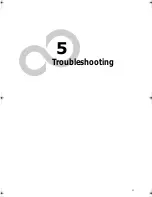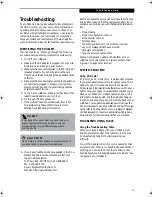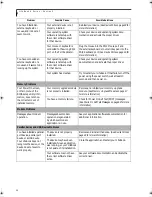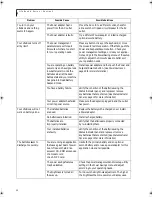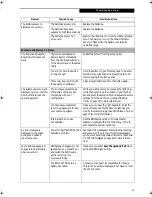
44
L i f e B o o k A S e r i e s – S e c t i o n 4
Hard Disk Drive
Your Fujitsu LifeBook contains a 6GB internal hard disk
drive.
FORMATTING THE HARD DISK DRIVE
The internal hard disk drive is formatted, or initialized,
at the factory. You do not need to format it under
normal circumstances. If you decide to reformat due to
corruption or upgrade, please refer to your operating
system documentation for the correct procedure.
Before you reformat your hard disk drive, please note:
■
Any data that currently resides on your hard disk drive
must be backed-up to floppy disks or other data
storage media, or it will be permanently lost. These
back-up disks can then be used to re-install and
restore your data. (See your operating system manual
for more information on backing-up your data files)
■
All application software that is installed on the
hard disk drive, must be re-installed from the
original source.
■
The factory-installed software, including the operating
system, can be restored using the Recovery CD that
came with your LifeBook.
MODULAR HARD DISK DRIVE
Your LifeBook may contain a modular hard disk drive in
addition to the internal hard disk drive. If your LifeBook
has a modular hard disk drive you will need to format
the drive before using it.
Formatting the Modular Hard Disk Drive
1. Boot the system. When the Fujitsu logo appears press
the [F8] key to bring up the Microsoft Windows
Startup Menu.
2. Select option 6 command prompt only, using the
arrow key and press [Enter].
3. At the
C:>
prompt, type
Fdisk
and
press [Enter].
4. You will see a long message appear on the screen. At
the bottom of the message you will see the option,
Do you wish to enable large disk
support (Y/N)...? [N].
Type
Y
to change
the option in the last statement to yes and press
[Enter] to continue.
5. You are now in the FDISK Options menu. Type
5
to select Change Current fixed disk drive and
press [Enter].
6. The next Change Current Fixed Disk Drive screen
displays info for both Primary(C:) & Secondary (D:)
Disks. Type
2
at the Fixed Disk Drive Number and
press [Enter].
7. You are now back in the FDISK Options menu
for drive D:. Press
4
in the Enter Choice: [ ] field
to go the Display partition information option
and press [Enter].
8. If the message
No partitions defined
appears at the bottom of the Display Partition Infor-
mation screen, press [Esc].
9. You are now back in the FDISK Options menu. Press
1
to change the Enter Choice: [ ] field to the Create
DOS partition or Logical DOS Drive option (it
should already be set to 1 as the default) and press
[Enter].
10. Press [Enter] again to select the default setting (#1)
Create Primary DOS Partition.
11. Fdisk will verify drive integrity and ask you if you
wish to use the maximum available size for Primary
DOS Partition. Type
Y
for Yes. A message appears
“Primary DOS partition created, drive letters
changed as added.” Press Esc to continue. In this
case the partition usage will be 100% or 10GB, this
number may vary depending on your drive size.
12. You are now back in the FDISK Options menu. Press
4
to display your partitions info.
13. You should see the following in the Create Primary
DOS Partition screen:
Partition
Status Type
Volume
Label
D:1
PRI DOS
Mbytes
System
Usage
6194*
Unknown
100%
Primary DOS Partition created
14. Press [Esc] three times to exit the Create Primary
DOS Partition screen and FDISK Options menu.
15. Restart your eB. when the Fujitsu logo appears, press
the [F8] key to bring up the Microsoft Startup
Menu.
16. Type
FORMAT D
: to format the hard drive. When
formatting is done, restart your LifeBook.
Your LifeBook will now detect the hard disk drive and
activate it within your system. The drive letters associ-
ated with the hard disk drive will be created and listed
under My Computer and Windows Explorer.
W A R N I N G
Reformatting the hard disk drive will erase all of the
data currently stored on it, including the operating
system and installed programs.
A_Series.book Page 44 Monday, June 26, 2000 2:28 PM
Summary of Contents for LifeBook A-4170
Page 8: ...L i f e B o o k A S e r i e s ...
Page 9: ...1 1 Preface ...
Page 10: ...2 L i f e B o o k A S e r i e s S e c t i o n 1 ...
Page 12: ...4 L i f e B o o k A S e r i e s S e c t i o n 1 ...
Page 13: ...5 2 Getting to Know Your LifeBook ...
Page 14: ...6 L i f e B o o k A S e r i e s S e c t i o n 2 ...
Page 34: ...26 L i f e B o o k A S e r i e s S e c t i o n 2 ...
Page 35: ...27 3 Getting Started ...
Page 36: ...28 L i f e B o o k A S e r i e s S e c t i o n 3 ...
Page 45: ...37 4 User Installable Features ...
Page 46: ...38 L i f e B o o k A S e r i e s S e c t i o n 4 ...
Page 59: ...51 5 Troubleshooting ...
Page 60: ...52 L i f e B o o k A S e r i e s S e c t i o n 5 ...
Page 74: ...66 L i f e B o o k A S e r i e s S e c t i o n 5 ...
Page 75: ...67 6 Care and Maintenance ...
Page 76: ...68 L i f e B o o k A S e r i e s S e c t i o n 6 ...
Page 80: ...72 L i f e B o o k A S e r i e s S e c t i o n 6 ...
Page 81: ...73 7 Specifications ...
Page 82: ...74 L i f e B o o k A S e r i e s S e c t i o n 7 ...
Page 85: ...77 8 Glossary ...
Page 86: ...78 L i f e B o o k A S e r i e s S e c t i o n 8 ...

